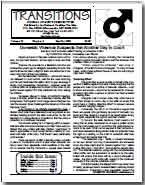
In August 2015, the Australian Senate Finance and Public Administration References Committee handed down their report into domestic violence in Australia. It made a number of positive findings and recommendations with regard to male victims of family violence. The most important was Recommendation 15:
8.54 The committee recommends that the Commonwealth Government recognise the need to provide appropriate services to male victims of domestic and family violence.
This follows on from the August 2012 report of The NSW Government Legislative Council’s Standing Committee on Social Issues inquiry into domestic violence trends and issues in NSW, which recognised:
…the gap in services for male victims and [encouraged] the [NSW] government to examine how services can most appropriately be provided to male victims of domestic violence.
Other relevant findings of the Senate report include the following.
1.11 The committee acknowledges that further work is required to address domestic and family violence against men and the data on its prevalence, noting that only 22 per cent of the respondents in the Public Safety Survey undertaken by the ABS were male.
4.8 While the prevalence data in the PSS was often cited in submissions, a limited number of submissions raised issues with methodology of the PSS. For example, Mr Paul Mischefski, Vice-President of Men’s Wellbeing Inc, Queensland, argued:
Despite repeated calls for this highly-regarded and quoted survey to achieve gender parity and include an equal number of female and male respondents, the survey has consistently shown an immense bias towards a female survey sample.
The 2005 survey included 11,800 females but only 4500 males. This heavy gender bias became even worse in the 2012 survey, where only 22% of respondents were male – less than one-quarter.
Impacts on male victims
2.35 While much of the evidence was focused on the impact of domestic and family violence on female victims, the committee did receive some evidence in relation to the impacts on male victims.
2.36 The One in Three Campaign quoted from the findings of a study conducted in 2010 by researchers at the Psychology Department of Edith Cowan University:
The data suggest[s] that male victims of intimate partner abuse and their children suffer a range of consequences, such as psychological distress (including psychological disorders such as depression and anxiety disorders), suicidal ideation, impaired self-concept (in particular around one’s sense of masculinity), and loss of work.
2.37 The researchers noted that despite these impacts, men were reluctant to disclose the abuse or seek help: The reasons for this are complex. The major factors appear to be men’s denial of what is happening; their fear that they will not be believed, and their fear that even if they are believed they will not be assisted or will be blamed for the abuse. Participants believed that men would find it easier to seek help and disclose the abuse if there were greater public acknowledgement that males can also be victims of abuse, if there were appropriate services for men, and if they were confident that they will be given effective help.
2.38 Dr Elizabeth Celi also described to the committee some of the impacts on male victims of domestic and family violence:
[T]here is a lot of shame in this issue and a lot of embarrassment already that they are in this position, and they have not received public education that certain psychologically abusive behaviours by their female partner—or even by other men in their lives—are actually abnormal and unproductive, and can have an effect on their mental and emotional health. Not having that information, they do not have a gauge of what is normal and when it becomes abnormal and unproductive. So it will take a while for men to actually feel competent to report their experience.
The other factor we need to consider is the social health aspects for men, where people disbelieve or invalidate their experience. That is a form of revictimisation. For someone who is already receiving mental and emotional abuse, social abuse or financial abuse, it is a very insidious and difficult-togauge thing. To then be disbelieved, or invalidated or told to ‘suck it up’ et cetera further inhibits their ability to report it. So it is easier actually to deal with it by yourself.
4.20 The One in Three Campaign also referred to NSW statistics, noting the NSW Bureau of Crime Statistics and Research (BOCSAR) findings:
BOCSAR also examined trends and characteristics of domestic homicides in NSW over the period January 2003 to June 2008. During this time, there were 215 victims of domestic homicide; 115 females and 100 males (almost one in two victims were male). Intimate partners were responsible for 43 per cent of domestic homicide victims (70 females and 23 males – one in four were male).
Domestic and family violence against men
4.21 As set out above, the PSS provides some data on the prevalence of domestic and family violence against men. However, submissions also highlighted other data which is available. For example, the One in Three Campaign cited the 1999 South Australian Interpersonal Violence and Abuse Survey which found:
32.3 per cent (almost one in three) victims of reported domestic violence by a current or ex-partner (including both physical and emotional violence and abuse) were male.
4.22 The NSW Government submission also provided some data on the prevalence of domestic and family violence against men:
In the twelve months to March 2014, 69 per cent of victims of domestic violence-related assaults in NSW were women. There were 21,664 female victims compared to 9,925 male victims. This equates to a rate per 100,000 population of 594 for females and 277 for males.
Services for male victims
8.40 Mr Greg Andresen, Senior Researcher, One in Three Campaign, told the committee that many male victims of domestic and family violence were unable to access crisis support services because most services catered primarily or exclusively for women. Noting that crisis support services are primarily the responsibility of the states and territories, he suggested there needed to be at least:
…a modicum of services on the ground so that when those men do come forward, there are some services for them to go to. At the moment if we have a flood of men coming forward…there are a whole lot of closed doors, that revictimises those men. We are not saying we want the same amount of services that women have, but just a modicum so that there is something for those men.
8.41 Mr Andresen also told the committee that there were no specialised services to support male victims from Aboriginal and Torres Strait Islander backgrounds or from the LGBTI community:
It is my belief that specific services for the Aboriginal and Torres Strait Islander community and the LGBTI community are necessary because there are specific needs that those communities have that are specific to them. The kinds of issues that a gay man being abused by his partner may face – around homophobia, around threats of being outed and all that sort of thing – are specific. I would say that those services are necessary, and underfunded if anything.
The full report can be dowloaded from aph.gov.au/Parliamentary_Business/Committees/Senate/Finance_and_Public_Administration/Domestic_Violence/Report


